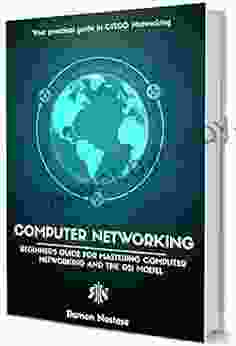The Beginner's Guide to Mastering Computer Networking, The Internet, and The OSI

4.3 out of 5
| Language | : | English |
| File size | : | 22061 KB |
| Text-to-Speech | : | Enabled |
| Screen Reader | : | Supported |
| Enhanced typesetting | : | Enabled |
| Print length | : | 186 pages |
| Lending | : | Enabled |
In today's digital age, computer networking is an essential skill for anyone who wants to succeed in the tech industry. Whether you're a student, a business professional, or a hobbyist, understanding how networks work can give you a major advantage.
This beginner's guide will teach you everything you need to know about computer networking, from the basics of the OSI model to the intricacies of the Internet. We'll cover everything from how data travels across networks to how to troubleshoot common network problems.
Chapter 1: The OSI Model
The OSI (Open Systems Interconnection) model is a framework that describes how data is transmitted across networks. It's a conceptual model, but it's important to understand the OSI model because it helps you to understand how networks work.
The OSI model has seven layers, each of which has a specific function. The layers are:
- Physical layer: This layer defines the electrical and physical characteristics of the network, such as the type of cables and connectors used.
- Data link layer: This layer provides error-free transmission of data across the physical layer.
- Network layer: This layer provides routing and addressing for data packets.
- Transport layer: This layer provides reliable delivery of data packets.
- Session layer: This layer manages the establishment, maintenance, and termination of network sessions.
- Presentation layer: This layer formats data for transmission across the network.
- Application layer: This layer provides services to applications, such as file transfer, email, and web browsing.
Chapter 2: Internet Protocols
The Internet is a global network of computers that use a set of protocols to communicate with each other. The most important Internet protocols are:
- TCP (Transmission Control Protocol): TCP is a reliable transport protocol that provides error-free delivery of data packets.
- IP (Internet Protocol): IP is a routing protocol that provides addressing and routing for data packets.
- UDP (User Datagram Protocol): UDP is an unreliable transport protocol that is used for applications that don't require reliable delivery of data packets.
- DNS (Domain Name System): DNS is a distributed database that translates domain names (such as ) into IP addresses.
Chapter 3: Common Network Problems
Network problems can be frustrating, but they're often easy to troubleshoot. Here are some of the most common network problems and how to solve them:
- No internet connection: This problem can be caused by a number of things, such as a loose cable, a faulty modem, or an outage from your ISP. To troubleshoot this problem, start by checking your cables and modem. If those are all working properly, then you should contact your ISP.
- Slow internet connection: A slow internet connection can be caused by a number of things, such as a congested network, a weak signal, or a problem with your router. To troubleshoot this problem, start by restarting your router. If that doesn't work, then you should try moving your router to a different location. If that still doesn't work, then you should contact your ISP.
- DNS errors: DNS errors can occur when your computer is unable to translate a domain name into an IP address. To troubleshoot this problem, try flushing your DNS cache. If that doesn't work, then you should try changing your DNS servers.
- Network security issues: Network security issues can be caused by a number of things, such as malware, hackers, and phishing attacks. To protect your network from security issues, you should keep your software up to date, use a firewall, and be careful about what you click on.
...
4.3 out of 5
| Language | : | English |
| File size | : | 22061 KB |
| Text-to-Speech | : | Enabled |
| Screen Reader | : | Supported |
| Enhanced typesetting | : | Enabled |
| Print length | : | 186 pages |
| Lending | : | Enabled |
Do you want to contribute by writing guest posts on this blog?
Please contact us and send us a resume of previous articles that you have written.
 Book
Book Novel
Novel Page
Page Chapter
Chapter Text
Text Story
Story Genre
Genre Reader
Reader Library
Library Paperback
Paperback E-book
E-book Magazine
Magazine Newspaper
Newspaper Paragraph
Paragraph Sentence
Sentence Bookmark
Bookmark Shelf
Shelf Glossary
Glossary Bibliography
Bibliography Foreword
Foreword Preface
Preface Synopsis
Synopsis Annotation
Annotation Footnote
Footnote Manuscript
Manuscript Scroll
Scroll Codex
Codex Tome
Tome Bestseller
Bestseller Classics
Classics Library card
Library card Narrative
Narrative Biography
Biography Autobiography
Autobiography Memoir
Memoir Reference
Reference Encyclopedia
Encyclopedia Richard Fortey
Richard Fortey Ralph Nader
Ralph Nader Timothy Garton Ash
Timothy Garton Ash Terez Mertes Rose
Terez Mertes Rose Peter Schjeldahl
Peter Schjeldahl Yetta Young
Yetta Young Ruthie Lindsey
Ruthie Lindsey Phylis Johnson
Phylis Johnson Sara Snow
Sara Snow Sara Barnes
Sara Barnes Ross Blankenship
Ross Blankenship Tamsin Ley
Tamsin Ley Robb Gilbear
Robb Gilbear Valeria Vegas
Valeria Vegas Q Hayashida
Q Hayashida Torkel Klingberg
Torkel Klingberg Pinde Fu
Pinde Fu Robert Ernest Hubbard
Robert Ernest Hubbard Robert D Bolen
Robert D Bolen Peter Ralph
Peter Ralph
Light bulbAdvertise smarter! Our strategic ad space ensures maximum exposure. Reserve your spot today!
 Dakota PowellFollow ·5k
Dakota PowellFollow ·5k Franklin BellFollow ·3.9k
Franklin BellFollow ·3.9k Casey BellFollow ·10.7k
Casey BellFollow ·10.7k Jett PowellFollow ·13.7k
Jett PowellFollow ·13.7k Greg CoxFollow ·16.7k
Greg CoxFollow ·16.7k Justin BellFollow ·18.3k
Justin BellFollow ·18.3k Brian WestFollow ·12.6k
Brian WestFollow ·12.6k Ian MitchellFollow ·10.4k
Ian MitchellFollow ·10.4k

 Mike Hayes
Mike HayesArthur Meighen: A Life in Politics
Arthur Meighen was one of Canada's most...

 Bryan Gray
Bryan GrayVindicated: Atlanta's Finest
In the heart of Atlanta, a...

 Houston Powell
Houston PowellHis to Defend: A Captivating Legal Thriller That Will...
An Unforgettable...

 John Green
John GreenUncover the Riveting Tale of "Hunted: Atlanta Finest" - A...
Prepare yourself for a...
4.3 out of 5
| Language | : | English |
| File size | : | 22061 KB |
| Text-to-Speech | : | Enabled |
| Screen Reader | : | Supported |
| Enhanced typesetting | : | Enabled |
| Print length | : | 186 pages |
| Lending | : | Enabled |















